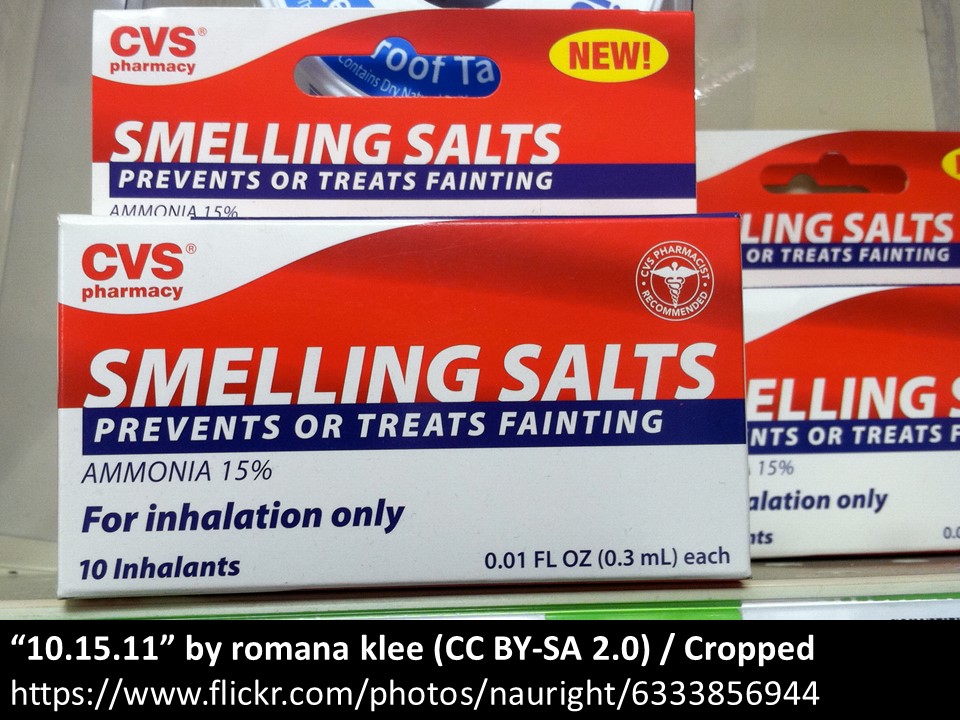Are Smelling Salts Bad for You?

The Bottom Line
Smelling salts contain ammonia-based chemicals, and are used to help revive people who have fainted or are lightheaded. When inhaled, the chemicals in smelling salts cause nose and throat irritation as well as temporary increases in heart rate. While smelling salts are generally safe when used as directed, prolonged inhalation may result in permanent lung damage or death.

What are smelling salts?
Smelling salts are typically used to revive people who have fainted or who feel lightheaded and dizzy. Smelling salts contain concentrated ammonia or ammonium compounds, and some products also contain essential oils. The ammonia-based chemicals have a strong, pungent odor that causes irritation of the lungs, which leads to a change in breathing patterns. In unconscious individuals, the change in breathing rate can also increase alertness. Smelling salts are used by inhaling the contents of a capsule or liquid solution, which is typically held at a distance of 4 to 6 inches from the affected individual’s nose.
What does smelling salt smell like?
The ammonia and ammonium compounds in smelling salts have a repulsive, sharp odor that is similar to that of many household cleaners. Ammonia’s odor is detectable at low concentrations for most people, but individuals who experience prolonged inhalational exposures may experience “olfactory fatigue”, a condition where the ability to detect an odor decreases over time.
Do smelling salts work?
Smelling salts have been used since the 13th century to treat fainting or lightheadedness. When inhaled, the strong odor causes a temporary increase in heart rate as well as blood flow within the brain. These effects occur within 15 seconds of smelling salt inhalation, and subside within a minute of inhalation.
Can smelling salts be used for waking up or anxiety?
Smelling salts have not been shown to be a useful treatment for anxiety. While they can be effective in increasing alertness in unconscious individuals, smelling salts are not scientifically proven to increase energy, prevent fatigue, or promote wakefulness. On social media platforms, some smelling salt manufacturers promote their products as a healthier alternative to energy drinks and a method of increasing alertness in truck drivers, firefighters, exhausted parents, and people suffering from alcohol hangover. However, smelling salts have not been studied for these uses and are not approved by the Food and Drug Administration (FDA) as stimulant drugs. In 2023, the FDA issued a warning to consumers to avoid using Nose Slap and Soul Slap smelling salt products that are advertised as promoting both energy and alertness.
What are side effects of smelling salts?
The ammonia in smelling salts is highly water-soluble. When ammonia comes into contact with moist areas of the body such as the eyes, nose, and throat, it reacts with the water in these tissues to form the chemical ammonium hydroxide. Ammonium hydroxide is a caustic chemical that causes eye, skin, and lung irritation upon contact. The chemical reaction that produces ammonium hydroxide also generates heat that can result in chemical burns of the affected organs. While inhalation of low concentrations of ammonia can cause irritating but self-limited symptoms such as eye burning and coughing, people who breathe in concentrated forms of ammonia can experience permanent lung damage. Inhalation of smelling salts can cause allergic reactions and worsen underlying lung disease such as asthma. In one case, a 14-year-old boy suffocated and died after repeated inhalation of smelling salts.
What are smelling salts used for at the gym?
Athletes often use smelling salts as a “pick me up” tool, prior to or during competition, to stimulate energy, increase alertness, and improve reaction times. Unlike other drugs that are used as stimulants, ammonia is not banned by the World Anti-Doping Agency. Smelling salts are often used by competitive powerlifters, frequently just prior to the deadlift (the final lift in powerlifting competitions), and the International Powerlifting Federation permits the inhalation of ammonia as long as it is used out of public view. However, smelling salts are not proven to improve strength or power in athletes, although they may increase an individuals’ perception of their own athletic performance. Historically, smelling salts were used to treat athletes with mild head injuries, but it is unlikely that they were effective when used for this purpose.
What should I do if I get sick after using smelling salts?
If you develop unexplained or unexpected symptoms after using smelling salts, get guidance from Poison Control immediately. Help from Poison Control is available at www.poison.org and by phone at 1-800-222-1222. Both options are free, confidential, and available 24 hours a day.
Kelly Johnson-Arbor, MD
Medical Toxicologist
Contact information for media requests
Poisoned?
Call 1-800-222-1222 or
Prevention Tips
- Only use smelling salts as directed on the package label.
- Do not use smelling salts as a treatment for fatigue or hangover.
- Consult your doctor before trying new practices advocated by social media influencers.
This Really Happened
A female powerlifter inhaled smelling salts just prior to competing for a national record. Soon afterwards, she developed a runny nose, eye redness, dizziness, and a headache. Her symptoms worsened over the next hour, and she also experienced wheezing, breathing difficulties, and a rash. She was diagnosed with a severe allergic reaction to smelling salts and was treated with epinephrine and diphenhydramine (Benadryl) injected through an IV. Her symptoms resolved after these treatments (from Herrick, 1983).For More Information
References
Bledsoe BE. This procedure stinks: the hazards of ammonia inhalant use. JEMS. 2003 Mar;28(3):52-3.
McCrory P. Smelling salts. Br J Sports Med. 2006 Aug;40(8):659-60.
Velaquez JR. The use of ammonia inhalants among athletes. Strength Cond J. 2011;33-35.
Poisoned?
Call 1-800-222-1222 or
Prevention Tips
- Only use smelling salts as directed on the package label.
- Do not use smelling salts as a treatment for fatigue or hangover.
- Consult your doctor before trying new practices advocated by social media influencers.
